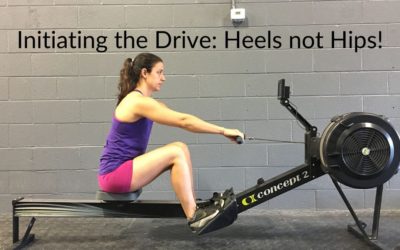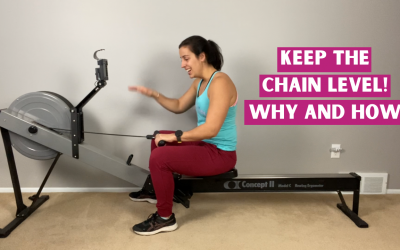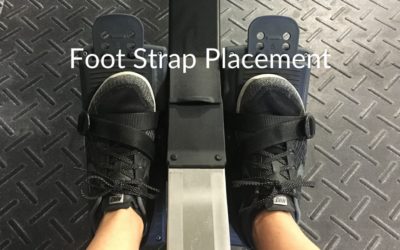Tips on Setting a Rowing Goal Split
About to do a rowing workout? Do you have an idea of what you should shoot for and what you should pull? In this post, I’m going to give you a couple tips to figure out what a good goal split could be. Sometimes you don’t have to worry about it, but if you like to have a goal split, I’m going to help you out with that.
What’s a Split?
A rowing split on any rowing monitor is going to be some sort of pace value. For example, calories per hour or time per 500 meters. Think miles per hour. It’s the same concept but different values.
Calories per hour and time per 500m are two very common split designations. Time per 500 meter is the one that you’ll see the most, and then calories per hour. Some people like to use watts. Whatever unit you use, these tips apply to any unit of measurement.
When I’m referring to a split and saying what goal split that you want to go for, assume that goal split is in whatever denomination that you use.
Comparing Similar Past Workouts
First thing that I would do is look at any of your past workouts that have similar length pieces with similar rest. Doesn’t have to be perfect, but if it’s close-ish you can go based off that.
For example, let’s say you’re starting a new workout and it’s 1000m pieces. Let’s say you’ve done some 500m pieces and some 1500m pieces, but you’ve never tried a 1000m piece at this specific stroke rate. You can look at what you did for your 500s, look at what you did at your 1500s, and decide on a split to start somewhere in the middle.
One thing you want to look at when you’re comparing workouts is how much rest you’re getting. Typically, how much rest is in a workout is going to tell you how hard your coach (or the plan) is expecting you to push. More rest, push harder.
Going back to the example, look at the rest. If it’s about the same, and if the stroke rate is about the same, that’s easily comparable. On the other hand, if you’re trying to do 1000s at 26spm, but you’ve only done 500s at 32spm, that’s going to be a bit different.
If the stroke rate is off by two beats, that’s pretty close. When the stroke rate is lower than you’re used to, it’s normal for the split to be slower. There’s not going to be an exact formula here. If the stroke rate and rest are different in the workout, you’re comparing it to, that workout isn’t a very good comparison to find a goal split.
Comparing Time vs Distance
You may have done a similar workout if you compare your distance vs time workouts. For example, if you hold a 2:30 /500m pace when you do 1000-meter pieces, that’s about 5 minutes worth of work. If you’re about to do 5-minute pieces, that 2:30 split is a good goal split for the 5 min pieces.
You can use a similar type of comparison between time vs distance-based workouts to be able to come up with a goal split.
Looking at Rest
When comparing workouts to look at a goal split, if the workout that you’re doing has more rest that implies a higher intensity.
I’m not going to program 30 seconds or 1 minute of rest and expect you to go all out unless the piece itself is 30 seconds long. As another example, if you’re doing a 2K pieces with 1 minute rest that’s probably steady state. If you’re doing 5-minute pieces with a 5-minute rest, the expectation is to push hard in that workout.
Using Intensity
When you have a plan that you’re follow, even if it’s a one-off workout, typically there will be some sort of intensity to shoot for. It could be percent effort or a general feeling of how hard to push.
Are these sprints? Is this steady state? Match that effort that is described for the workout. If you don’t know what that kind of effort feels like, make a good guess and evaluate how you’re feeling after each piece and then again after the workout.
Using the intensity goal over a goal split is helpful when you’re sorer, didn’t get as much sleep, etc. The effort prescribed for the workout will be the same, but since you’re tired and sore that may cause you to hold a slower split. That’s ok!
If you have a good program, intensity levels should be included in your program.
A Goal Split is Optional
You don’t have to have a goal split before a workout. It can be helpful, but it’s not required. You might be happy with wherever you’re at for the day. However, I tell my clients to try not to fly and die. Fly and die means going all out for the first one and finishing with a split MUCH lower than when you started.
Ideally, you’re trying to be consistent. You’re trying to find an intensity and a consistency that you’re able to hold based on how long the piece is and how long the rest is. It’s more ideal to be consistent, but even if you do fly and die, it’s not the end of the world. Now you know a better way to approach the workout next time you do it.
You have an average of the whole workout to go off of. Next time you do a workout that’s similar, start at that average and work to hold a consistent split that challenges you. Then, you can work to be consistently faster.
There’s no rush to get it perfect the first time around. Pick what you think you can hold and see if you can. You don’t have to do all this research and go back and look and compare workouts. You can if you want. Believe me, go for it if you want to! It’s entirely optional.
Even if you’re consistent, maybe you realize towards the end, oh, I could have pushed a little bit harder. Now you know, and you put that in your notes to remember for next time.
Figuring out where to start in your rowing workout is going to be a learned skill. You’re not going to hop on and know immediately what split to hold for your workout when you do that workout for the first time. It’s going to take time and experience to get there.
The more workouts that you do, the different kind of workouts that you do, the more knowledge you’re going to have about your own abilities and what you can pull. From there, it gets easier to determine what number you’ll want to see on the screen.
Initiating the Drive: Heels not Hips!
A common technique fault that I see on the rowing machine is when athletes are initiating the drive with their hips and not their heels. Watch the video above to see what I mean. If you are initiating the drive with your hips, you will lean back and this puts you in...
Keeping the Chain Level
You may have heard that in your rowing stroke, it's important to keep that chain level throughout your entire rowing stroke. Here, I'm going to teach you why it's important and why keeping that chain level can affect other parts of your stroke and make you a better...
Foot Strap Placement
The placement of the foot straps on your shoes can be just as important as anything else in your rowing stroke. In fact, having proper foot placement could fix any technical issues you may not be aware of. When you change where your foot sits, it affects the angle of...



